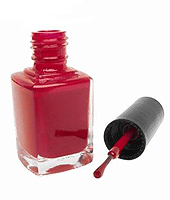Spiked!
Conventional nail polish contains dangerous chemicals that can be inhaled or absorbed through the skin.

Today, most commercial nail polishes, unless natural alternatives, contain toluene, a clear, colourless liquid used to make products such as dyes, paints, paint thinners and explosives. Solvents such as toluene, which give nail polish its fluid quality and improve drying time, absorb easily through the skin or through inhalation.
Toluene is a hydrocarbon (C7H8) that's found in crude oil and is produced during the manufacture of gasoline and other fuels. It can affect the nervous system, causing depression, headaches, nausea and feelings of intoxication, says Judy Vance, author of Beauty to Die For: The Cosmetic Consequence. Low to moderate levels of exposure can cause symptoms from tiredness to loss of hearing and colour vision, reports the Agency for Toxic Substances and Disease Registry in Atlanta, Ga. Long-term exposure of workers has been linked to minor abnormalities in neuropsychological tests and genetic changes.
In November 2000, the US organization Environmental Working Group warned women of childbearing age to avoid using nail polish that contained the chemical dibutyl phthalate (DBP). Laboratory animals given DBP had higher numbers of offspring with birth defects. (Pthalates is a family of toxic, industrial, plasticizing compounds used to make nail polish flexible; products that contain them do not always require labelling.)
However, a spokesman for The Cosmetic, Toiletry, and Fragrance Association in the US has claimed that phthalates are safe. Dr. Jerry McEwen, the association's vice-president of science, pointed out that the Food and Drug Administration, the Environmental Protection Agency, Health Canada and other scientific bodies in Europe, North America and Japan have examined phthalates and allow their use.
Health Canada has issued no warnings of risks related to nail polish use. But in 1995, the federal body alerted consumers to keep certain brands of non-acetone nail polish remover containing methanol away from children; these brands were not packaged in child-resistant containers. If ingested, methanol can cause blindness and, in some cases, death.
Natural Nail Products
As an alternative to chemical-laden nail polishes, the emergence of natural products is a recent phenomenon. A popular choice in the Lower Mainland of BC No Miss Nail Polish was introduced less than two years ago. This Florida-made product, free of formaldehyde, toluene and harmful dyes, features hundreds of colours from orange and turquoise to purple.
"It's fun, people like it, and we've sold lots," says Matthew Breech, sales manager for TallGrass Distribution, which stocks No Miss polish in 50 outlets across BC, including all major natural food stores such as Capers and Choices.
Other alternative products, which contain no toluene, formaldehyde or DBP, include SANTE nail polishes, L'Oreal Paris Jet-Set Quick Dry Enamel and Go Natural non-toxic nail polishes. Consult the Internet for additional products.
Chemicals in Nail Products
Glycol ethers - They have been linked with birth defects in animal studies, and low exposure rates caused lower sperm counts in human males. Reports have linked exposure with higher-than-normal rates of miscarriage.
Methyl methacrylate - It was banned in the US in 1974 because it caused irritation and dermatitis; however, it was still in use in nail salons and artificial nail products in the 1990s.
Formaldehyde - This neurotoxin proved carcinogenic to two strains of lab rats. It can cause insomnia, coughing, nosebleeds and rashes. Professionals exposed long term to this chemical have a higher-than-average rate of death from brain cancer.
Ethyl alcohol - It irritates eyes and mucous membranes and can depress the central nervous system. Benzoyl peroxide - Inhalation of this plastics additive can irritate mucous membranes. Animal studies have shown that it can promote cancer on mouse skin.
History of Nail Polish Use
1320-1550: No one knows the favourite nail colour of Cleopatra or Nefertiti, but it just might have been gold. Archaeologists have unearthed Egyptian mummies with golden fingernails, and historical records show that wealthy women in ancient Egypt did indeed paint their nails. It is believed they used natural products from plants or animals for their polish.
1368-1644: Coloured polish in a variety of forms graced the fingernails of women around the world since the early ages. During China's Ming Dynasty, women made nail lacquer from a combination of beeswax, egg whites, gelatin, vegetable dyes and Arabic gum.
Early formulators used castor oil to make the polish more flexible while natural resins were included to soften the nail and improve drying time.
In the late 19th century, women in the US used a solution of nitrocellulose in a mixture of alcohol and ether. When large stocks of nitrocellulose, used in explosives during the First World War, were available in the early 1920s, this technology gained further development for nail polish. The car industry soon adopted nitrocellulose lacquer for automobile paint because of its
glossy, fast-drying qualities.
1920's: At this time, the first nail lacquer was clear and thin. Later, rhodamines (red or pink chemical dyes) were added to give colour to the clear products.
Around 1925, resourceful manufacturers took advantage of the plentiful celluloid film scraps discarded by the thriving movie industry to make nail polish; they cleaned the scraps and added sandarac gum resin, castor oil, acetone, denatured alcohol and phloxine for colour. Acetates were added 10 years later, and basic nail polish formulas remained almost unchanged for many decades to follow.
Today, natural nail polishes are a recent phenomenon, gaining wider acceptance as consumers seek products without harmful chemicals.




